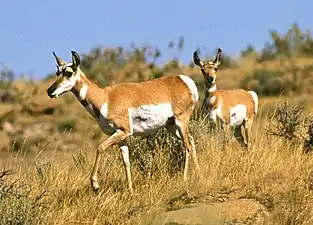Antilocapridae
The Antilocapridae are a family of artiodactyls endemic to North America. Their closest extant relatives are the giraffids[1] with which they comprise the superfamily Giraffoidea. Only one species, the pronghorn (Antilocapra americana), is living today; all other members of the family are extinct. The living pronghorn is a small ruminant mammal resembling an antelope.
| Antilocapridae | |
|---|---|
 | |
| Pronghorns in Fort Keogh, Montana | |
| Scientific classification | |
| Kingdom: | Animalia |
| Phylum: | Chordata |
| Class: | Mammalia |
| Order: | Artiodactyla |
| Superfamily: | Giraffoidea |
| Family: | Antilocapridae J. E. Gray, 1866 |
| Genera | |
|
Antilocapra | |
In most respects, antilocaprids resemble other ruminants. They have a complex, four-chambered stomach for digesting tough plant matter, cloven hooves, and small, forked horns. Their horns resemble those of the bovids, in that they have a true horny sheath, but, uniquely, they are shed outside the breeding season, and subsequently regrown. Their lateral toes are even further diminished than in bovids, with the digits themselves being entirely lost, and only the cannon bones remaining. Antilocaprids have the same dental formula as most other ruminants: 0.0.3.33.1.3.3.
Evolution
The antilocaprids evolved in North America, where they filled a niche similar to that of the bovids that evolved in the Old World. During the Miocene and Pliocene, they were a diverse and successful group, with many different species. Some had horns with bizarre shapes, or had four, or even six, horns. Examples include Osbornoceros, with smooth, slightly curved horns, Paracosoryx, with flattened horns that widened to forked tips, Ramoceros, with fan-shaped horns, and Hayoceros, with four horns.[2][3]
Species
- Subfamily Antilocaprinae
- Tribe Antilocaprini
- Genus Antilocapra
- Antilocapra americana - pronghorn
- A. a. americana - Common pronghorn
- A. a. mexicana - Mexican pronghorn
- A. a. peninsularis - Baja California pronghorn
- A. a. sonoriensis - Sonoran pronghorn
- A. a. oregona - Oregon pronghorn
- Antilocapra pacifica[4]
- Antilocapra americana - pronghorn
- Genus †Texoceros[5]
- Texoceros altidens
- Texoceros edensis
- Texoceros guymonensis
- Texoceros minorei
- Texoceros texanus
- Texoceros vaughani
- Genus Antilocapra
- Tribe †Ilingoceratini
- Genus †Ilingoceros
- Ilingoceros alexandrae
- Ilingoceros schizoceros
- Genus †Ottoceros[6]
- Ottoceros peacevalleyensis
- Genus †Plioceros[7]
- Plioceros blicki
- Plioceros dehlini
- Plioceros floblairi
- Genus †Sphenophalos[5]
- Sphenophalos garciae
- Sphenophalos middleswarti
- Sphenophalos nevadanus
- Genus †Ilingoceros
- Tribe †Proantilocaprini
- Genus †Proantilocapra
- Proantilocapra platycornea
- Genus †Osbornoceros
- Osbornoceros osborni
- Genus †Proantilocapra
- Tribe Stockoceratini
- Genus †Capromeryx - (junior synonym Breameryx)
- Capromeryx arizonensis - (junior synonym B. arizonensis)
- Capromeryx furcifer - (junior synonyms B. minimus, C. minimus)
- Capromeryx gidleyi - (junior synonym B. gidleyi)
- Capromeryx mexicana - (junior synonym B. mexicana)
- Capromeryx minor - (junior synonym B. minor)
- Capromeryx tauntonensis
- Genus †Ceratomeryx[6]
- Ceratomeryx prenticei
- Genus †Hayoceros
- Hayoceros barbouri
- Hayoceros falkenbachi
- Genus †Hexameryx
- Hexameryx simpsoni
- Genus †Hexobelomeryx[6]
- Hexobelomeryx fricki
- Hexobelomeryx simpsoni
- Genus †Stockoceros
- Stockoceros conklingi (junior synonym S. onusrosagris)
 Stockoceros conklingi skeleton
Stockoceros conklingi skeleton
- Stockoceros conklingi (junior synonym S. onusrosagris)
- Genus †Tetrameryx
- Tetrameryx irvingtonensis
- Tetrameryx knoxensis
- Tetrameryx mooseri
- Tetrameryx shuleri
- Tetrameryx tacubayensis
- Genus †Capromeryx - (junior synonym Breameryx)
- Tribe Antilocaprini
- Subfamily †Merycodontinae
- Genus †Cosoryx
- Cosoryx agilis
- Cosoryx cerroensis
- Cosoryx furcatus
- Cosoryx ilfonensis
- Cosoryx trilateralis
- Genus †Meryceros[6]
- Meryceros crucensis
- Merycerus crucianus
- Meryceros hookwayi
- Meryceros joraki
- Meryceros major
- Meryceros nenzelensis
- Meryceros warreni
- Genus †Merycodus
- Merycodus furcatus
- Merycodus grandis
- Merycodus necatus
- Merycodus prodromus
- Merycodus sabulonis
- Genus †Paracosoryx[8]
- Paracosoryx alticornis
- Paracosoryx burgensis
- Paracosoryx dawesensis
- Paracosoryx furlongi
- Paracosoryx loxoceros
- Paracosoryx nevadensis
- Paracosoryx wilsoni
- Genus †Ramoceros
- Ramoceros brevicornis
- Ramoceros coronatus
- Ramoceros marthae
- Ramoceros merriami
- Ramoceros osborni
- Ramoceros palmatus
- Ramoceros ramosus
- Genus †Submeryceros[6]
- Submeryceros crucianus
- Submeryceros minimus
- Submeryceros minor
- Genus †Cosoryx
References
- "Pronghorn (Antilocapra americana) Fact Sheet: Taxonomy & History". International Environment Library Consortium. Retrieved 8 August 2020.
- Savage, RJG; Long, MR (1986). Mammal Evolution: an illustrated guide. New York: Facts on File. pp. 232–233. ISBN 0-8160-1194-X.
- Palmer, D., ed. (1999). The Marshall Illustrated Encyclopedia of Dinosaurs and Prehistoric Animals. London: Marshall Editions. p. 280. ISBN 1-84028-152-9.
- Richards, G.D.; McCrossin, M.L. (1991). "A new species of Antilocapra from the late Quaternary of California". Geobios. 24 (5): 623–635. doi:10.1016/0016-6995(91)80027-W.
- Davis, E.B.; Calède, J.J. (January 2012). "Extending the utility of artiodactyl postcrania for species-level identifications using multivariate morphometric analyses". Palaeontologia Electronica. 15 (1): 1A:22p. Retrieved 13 August 2020.
- Semprebon, G.M.; Rivals, F. (September 2007). "Was grass more prevalent in the pronghorn past? An assessment of the dietary adaptations of Miocene to Recent Antilocapridae (Mammalia: Artiodactyla)". Palaeogeography, Palaeoclimatology, Palaeoecology. 253 (3–4): 332–347. doi:10.1016/j.palaeo.2007.06.006.
- Carranza-Castenada, O.; Aranda-Gomez, J.J.; et al. (April 2013). "The Early-Late Hemphillian (HH2) faunal assemblage from Juchipila Basin, State of Zacatecas, Mexico, and its biochronologic correlation with other Hemphillian faunas in central Mexico" (PDF). Contributions in Science. 521: 13–49. S2CID 53606726. Retrieved 13 August 2020.
- Beatty, B.L.; Martin, L.D. (June 2009). "The earliest North American record of the Antilocapridae (Artiodactyla, Mammalia)". PalaeoBios. 29 (1): 29–35. Retrieved 13 August 2020.